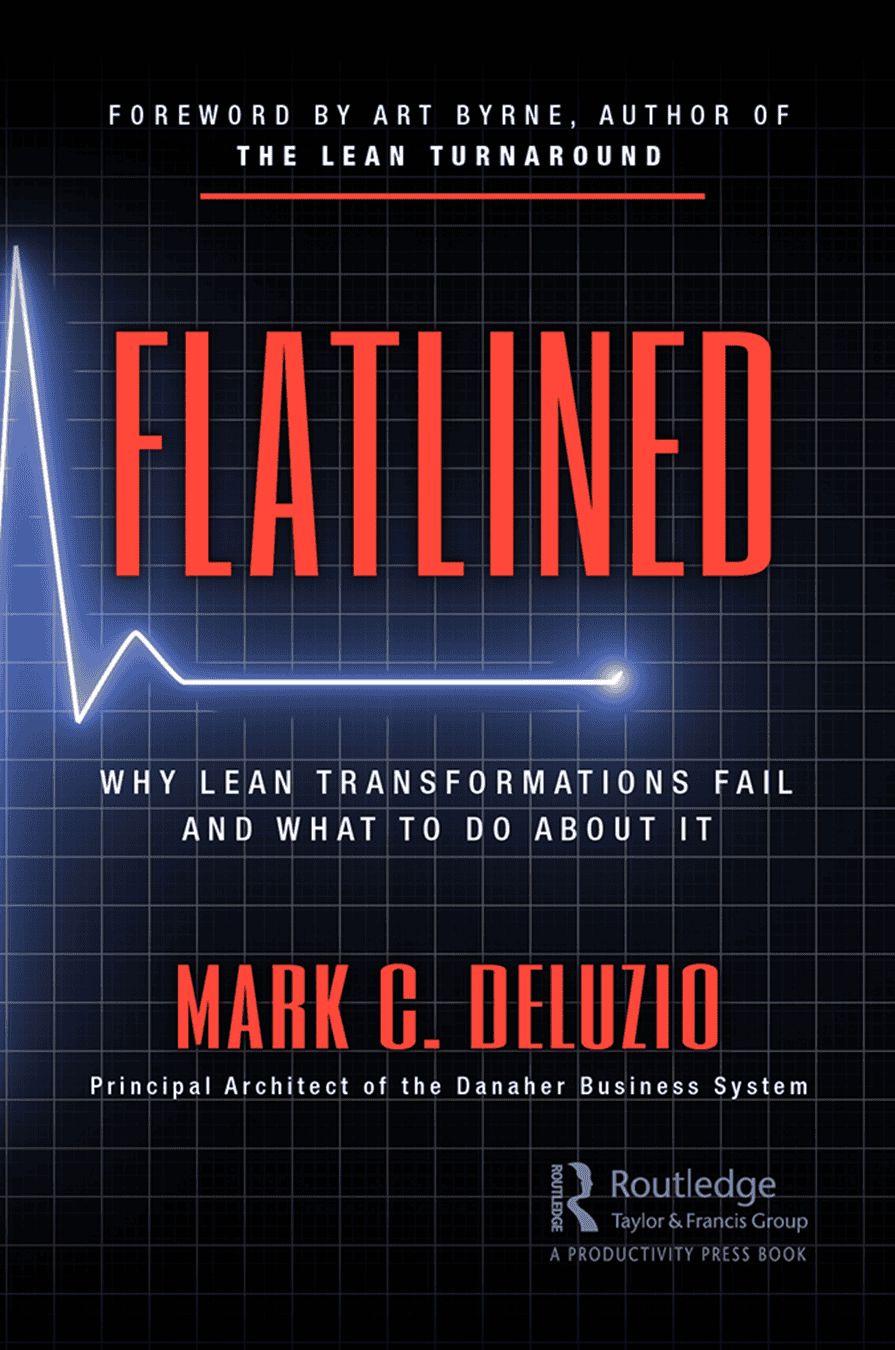In pursuit of operational excellence, many organizations embark on their Lean transformation journey with the hope of achieving efficiency, reducing waste, and enhancing overall performance. Lean transformation has the immense potential to elevate an organization’s operations and effectiveness from the ground up, acting as the catalyst for vast evolution when implemented correctly. We’re talking about the opportunity to generate significant growth and profitability. However, the path to Lean success is riddled with challenges and can sometimes fail due to a variety of avoidable reasons.
Understanding the reasons behind failures is crucial for applying effective solutions, and luckily, this article will give you a brief, digestible overview of how to identify and overcome such pitfalls. To take a deeper dive into this topic, purchase the book Flatlined: Why Lean Transformations Fail and What to Do About It, written by our very own Mark DeLuzio.
Reasons for Failure and Effective Solutions
1. Lean is used as a short-term tactical tool:
Lean methodologies are sometimes treated as quick fixes rather than as a long-term strategy to be implemented throughout all facets of an organization. When viewed merely as a short-term solution, organizations fail to unlock the full potential of Lean principles and can wind up losing momentum toward long-term success and expansion.
Solution: Shift to a Lean mindset
Transforming an organization’s culture begins with adopting a Lean mindset. So, what does that mean, exactly? A Lean mindset is a way of thinking and operating that emphasizes continuous improvement, waste reduction, and customer value. It involves a proactive approach to problem-solving, a commitment to efficiency, and a focus on empowering employees at all levels of an organization. Encourage a shift in thinking where employees continuously seek improvement, embrace change, and prioritize learning and customer value.
As your business embarks upon its own Lean transformation, focus on the long-term application of Lean practices and methodologies to ensure a strong and sturdy foundation. Consistently check in with your team of leaders to reflect on how employees are adapting, what is working, and what is not.
2. Disconnected Lean initiative:
When the Lean initiative is not connected to the broader business strategy and operates in isolation from the strategic level, it becomes challenging to sustain. All components of Lean should align with where your leadership envisions your company heading.
Solution: Align your Lean transformation with your business strategy
Integrate Lean initiatives into the broader business strategy by developing accountability measures that ensure leadership and management are consistently evaluating the impact and implementation of Lean principles to ensure cohesion. Take measures that ensure Lean principles align with the organization’s goals, fostering a seamless connection between strategic objectives and day-to-day operations.
Additionally, you should strive to successfully infuse Lean principles into the organization’s core values and culture by restructuring the foundation to align with these initiatives. This serves as an incremental step in achieving lasting success with a Lean transformation.
3. Function-centric optimization:
Focusing solely on optimizing individual functions without considering the holistic enterprise perspective often leads to suboptimal outcomes, ones that can be avoided when prioritizing the organization as a whole. Lean transformation emphasizes department-wide and cross-functional collaboration. The interconnectedness of different business functions must be recognized and addressed for a successful Lean transformation – without it, failure is far more likely.
Solution: Make Lean an enterprise-wide endeavor
Extend Lean beyond individual functions; make it an enterprise-wide initiative. Collaborate across departments, breaking down silos to create a unified approach that, again, aligns with the overarching corporate strategy and direction. Encourage connection and communication throughout departments, allowing for new ideas and improvements to emerge.
To strive for a unified approach, Lean transformation stresses the need for consistent collaboration and communication across company departments, as well as the importance of valuing each employee’s input and feedback.
4. Hands-off leadership:
Leadership plays a pivotal role in Lean success, as well as the health of an organization as a whole. When an organization begins its Lean transformation journey, an incremental aspect involves shifts in leadership and management, requiring leaders to take a front seat and be highly involved. A lack of active involvement and commitment from leaders results in a disengaged workforce and hinders the cultural shift necessary for Lean principles to thrive.
Solution: Evolve your company’s culture with Lean principles
Leaders should help cultivate a culture that values continuous improvement, collaboration, and problem-solving. Leadership must also actively promote and demonstrate Lean principles, creating an environment where employees are empowered to contribute to the Lean journey. Without everyone’s commitment to the transformation, you won’t be able to tap into your full potential.
5. Failure to implement the “BASICS”
Neglecting fundamental Lean practices designed to improve efficiency and effectiveness can undermine the entire Lean transformation process. Often, business leaders either avoid the basics because they can be difficult to master or they fall off entirely because of distractions or lack of commitment. The “BASICS” include Heijunka level scheduling, standard work, kaizen, just in time, jidoka, and the SQDC hierarchy. Overlooking these foundational elements prevents the organization from building a robust Lean framework, ultimately leading to failure. Even worse, without these “BASICS,” you will be practicing “fake Lean,” even if you believe the opposite.
Solution: Default to the “BASICS”
Establish a strong foundation by consistently applying Lean fundamentals, and defaulting to the “BASICS.” Each of these takes commitment, as they are not all easily mastered. However, a commitment to these proven tenets will help you reach your full potential as an organization. If you’ve been trying to practice Lean but haven’t seen success in your implementation, these core principles can get you back on track.
Turning Failures into Successes: Lean Horizons
A successful Lean transformation requires a holistic and strategic approach, with consistency from leadership and a commitment to long-term success. By addressing the common pitfalls outlined above and implementing these solutions, organizations can pave the way for a sustainable Lean culture that drives continuous improvement and lasting success.
To learn more about the power of Lean transformation and how our experienced team at Lean Horizons Consulting can help, contact us today!

